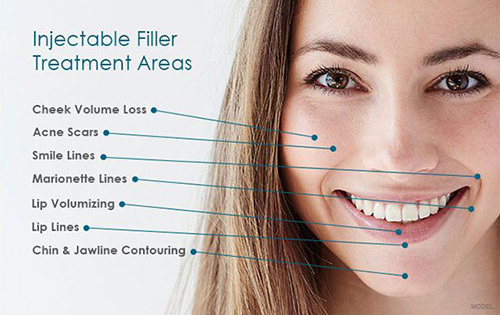Until recently, the only way to address problems caused by facial skin laxity—such as jowls and drooping cheeks—was facelift surgery. After all, while skin resurfacing treatments can help to restore some degree of firmness, once loose skin is present, only a scalpel can truly remove it. However, while the approach of relying on injectable compounds and skin resurfacing until facelift surgery becomes absolutely necessary works for many patients, not everyone is willing or able to have surgery. If you’re in this group, you’ll be happy to know that a new type of procedure has been developed to fill in the gap between noninvasive facial rejuvenation and facelift surgery: The “thread lift.”
.
thread lift is a type of procedure wherein temporary sutures are used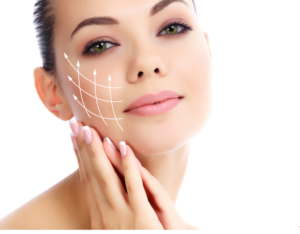 to produce a subtle but visible “lift” in the skin. Instead of removing the patient’s loose facial skin surgically, the physician simply suspends it by stitching up portions of it. This has the effect of pulling the skin back slightly and therefore lifting and tightening the face. In addition to being ideal for lifting the skin, threads combat aging in another way:
to produce a subtle but visible “lift” in the skin. Instead of removing the patient’s loose facial skin surgically, the physician simply suspends it by stitching up portions of it. This has the effect of pulling the skin back slightly and therefore lifting and tightening the face. In addition to being ideal for lifting the skin, threads combat aging in another way:
by provoking the body’s “healing response” and causing the body to direct large surges of collagen to treated areas. This is important because of the vital role collagen plays in the aging process.
Collagen helps support “growth factors” that greatly influences the condition of our skin. In addition to being used for wound healing, collagen helps to keep our skin strong, voluminous and supple. As we get older, our bodies gradually produce less and less collagen, which leads to an 80% reduction in skin thickness by about age 70. This loss of volume and strength is a large factor in the creation of excess skin and wrinkles. As the skin grows weaker, it’s no longer able to support the tissues beneath it adequately, meaning that gravity pulls it downwards and stretches it. Infusing the skin of the face with fresh collagen when the signs of skin laxity are still mild can help to both reduce looseness (by thickening and hydrating the skin) and prevent it from getting worse (by strengthening the skin).
For many patients, the biggest advantage of having a thread lift rather than a facelift is the greatly reduced recovery time associated with thread lifts. When a patient has facelift surgery, he or she must be heavily sedated; as such, the patient must arrange for someone to drive him or her home from the hospital. Most facelift patients also require around the clock assistance from a caretaker for at least three days after they have surgery. Furthermore, if the patient still has children at home, childcare aid may also be needed. Facelift patients usually need to take one to two weeks off of work, too, in order to heal.
than a facelift is the greatly reduced recovery time associated with thread lifts. When a patient has facelift surgery, he or she must be heavily sedated; as such, the patient must arrange for someone to drive him or her home from the hospital. Most facelift patients also require around the clock assistance from a caretaker for at least three days after they have surgery. Furthermore, if the patient still has children at home, childcare aid may also be needed. Facelift patients usually need to take one to two weeks off of work, too, in order to heal.
Recovery from a thread lift, on the other hand, is comparatively easy. Thread lifts can be performed under local, rather than general anesthesia, meaning that thread lift patients can drive themselves home and look after themselves immediately after having their procedure. While some patients will experience a little bit of soreness, redness and swelling after having a thread lift and therefore wish to take the rest of the day off, most can return to work immediately. Strong pain medication is seldom needed after having a thread lift, making it easier for patients to return to their normal routine. This procedure is therefore ideal for people who have children at home or those who have busy, demanding careers.
While thread lift recovery is not particularly intensive, patients will still have to take a few minor precautions while healing. It’s important to make sure that you don’t rub your face vigorously while cleansing it or applying moisturizer for at least a week after having threads placed. You should also try to prop your head up slightly so that you don’t roll over directly onto your face while sleeping.
Thread lifts are low risk, thanks to how noninvasive they are. There is virtually no risk of scarring, severe bruising, bleeding or other complications after having a thread lift. In rare cases, patients may experience irritation, infection or their sutures becoming visible under their skin. If this occurs, however, the sutures can simply be removed and the patient’s face will return to its prior state.
Finally, because thread lifts are much easier to perform than facelift surgery, they are much more affordable.
O
ne of the best things about this treatment is it only takes about one hour. After that, you’re free to go back to work or whatever else you had scheduled for the rest of your day.
B
efore treatment starts, we will apply a topical numbing agent and local anesthetic to the treatment site. The needle used during this treatment is so fine it will not cause any pain. However, we provide anesthesia to ensure you feel no discomfort during the treatment.
O
nce the anesthetic has taken effect, your treatment will begin. The PDO threads are inserted via blunt tip needles, called cannulas, or sharp-tipped needles. Once inserted into the appropriate layer of skin, they act as anchors as the skin is lifted upwards. Then, the excess threads are cut off.
T
here are several types of PDO threads, and each serves its own unique purpose. Depending on your aesthetic goals, your PDO provider may use one or many thread types during your anti-aging treatment.
T
here are two primarily types of PDO threads, These are floating 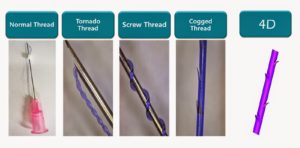 non-barbed threads and floating barbed threads. Sub-classifications of non-barbed threads include braided threads and mono-filament threads. Sub-classifications of barbed threads include:
non-barbed threads and floating barbed threads. Sub-classifications of non-barbed threads include braided threads and mono-filament threads. Sub-classifications of barbed threads include:
You may hear PDO threads described with names such as “heart barbs”, “tornado” or “double screw”. These are all references to various barbed PDO threads.
I
t absolutely matters what type or types are PDO thread is used during your PDO thread lift. Besides the distinct difference in shape, PDO threads come in varying lengths and thicknesses. Factors affected by the type of thread used include tensile strength, efficacy, quality and cost of treatment.
T
his treatment is completely safe. It is approved by the FDA for safety and efficiency. Moreover, hundreds of thousands of treatments have been performed and there are no reports of allergic reactions, sensitivities to the threads, or serious side effects or risks.
S
ince PDO thread lifts are non-invasive, there isn’t a lot you need to do to prepare. However, there are some precautionary measures you can take to ensure the best results from your treatment. Here are things you should avoid one to two days before treatment:
T
here are not a lot of special after-care requirements to this treatment. However, you should hold off on any dental treatments for the first two weeks after your PDO thread lift. Holding your mouth open for an excessive period of time can affect the results of your treatment. Moreover, you’ll want to sleep on your back for the first couple of weeks. This ensures you don’t put too much pressure on one side of your face.
A
PDO thread lift is customized to your unique skin type, skin texture and aesthetic goals. Depending on the area you want treated, you may receive three or four carefully placed barbed threads. Different threads are used for varying degrees of lift, skin tightening and cellular rejuvenation.
ecause a PDO thread lift is so versatile, it can treat virtually any area of the face. These include the:
The cheeks and the lower face/neck region are the most commonly treated. The cheeks and lower face are great regions to treat because they lend themselves so well to synergistic skin lifting treatments like HIFU therapy.
S
ome results of the treatment, such as skin lifting and some of the contouring effects, are visible immediately after treatment. In fact, your skin may look tighter when you walk out of our office than it will a week later.
T
he final results of your PDO thread lift will be seen within one to two months of your treatment. How long it takes you personally depends a lot on your age. Your age is one of the leading factors in how quickly your body produces new, healthy collagen. Collagen is the protein responsible for plumping up your cheeks, filling in fine lines and smoothing out wrinkles.
M
ost of our clients enjoy satisfactory results after just one treatment. Come in six to nine months after your first treatment so we can determine if you need a follow-up treatment. After that, you shouldn’t need another treatment for three years.
I
f you’re looking to correct uneven lines, wrinkles, gaunt facial features or skin laxity of the face, you are a good candidate for a PDO thread lift. You are a particularly good candidate for this treatment if you want an instant facial lift but don’t have the time or money to commit to a traditional face The ideal thread lift candidate is usually in his or her late thirties to early fifties, whereas most patients over the age of about 55 will benefit more profoundly from facelift surgery. Thread lifts can, however, provide a facelift alternative for older patients who are unable to have surgery for medical reasons. Because thread lifts can be performed under local anesthesia, many people who have age-related conditions that make them ineligible for surgery (like high blood pressure, type two diabetes and cardiovascular disease) can safely have this treatment. If you have any outstanding health conditions, make sure to talk to your doctor about whether or not a thread lift might be right for you.
It’s important to understand that while no lifting technique can produce permanent results, facelift surgery will usually produce longer lasting results than a thread lift. The results of facelift surgery can last up to a decade, whereas a thread lift will generally last from one to three years. However, because the thread lift procedure is so low-risk, patients who like the results of their thread lift can usually opt to have a fresh set of temporary sutures placed once their old sutures are absorbed by the body lift.
T
he best complementary treatments to your PDO thread lift depend on the results you’re looking to achieve. If you are extremely concerned about lines and wrinkles exacerbated by facial motions, neuromodulators work best. If you’re more worried about static lines and wrinkles, dermal fillers are the perfect complement for your PDO thread lift.
euromodulators (e.g. Botox)
Neuromodulators are a type of injectable with the active ingredient botulinum  toxin type A. Common examples include Dysport, Xeomin and Botox. Let us know during your initial consultation if you are planning on a treatment to complement your PDO thread lift. You can’t lie down for a couple hours after Botox to ensure the neurotoxin doesn’t spread outside the targeted area, so you will need to receive your PDO thread lift first.
toxin type A. Common examples include Dysport, Xeomin and Botox. Let us know during your initial consultation if you are planning on a treatment to complement your PDO thread lift. You can’t lie down for a couple hours after Botox to ensure the neurotoxin doesn’t spread outside the targeted area, so you will need to receive your PDO thread lift first.
How Do Neuromodulators Work?
Neuromodulators work by blocking the communication of neurotransmitters between your nerve endings and muscles. This reduces the activity of hyperactive muscles, temporarily eliminating lines and wrinkles which are apparent when your facial muscles are moving.
Dermal Fillers (e.g. Juvederm)
Dermal fillers work very similarly to PDO thread lifts in that they stimulate your body’s natural collagen production process. They contain the active ingredient hyaluronic acid, more commonly known as HA. One of the most popular FDA-approved dermal fillers is Juvederm. It comes in several variations, including Juvederm Ultra, Juvederm Ultra Plus, Juvederm Volbella and Juvederm Voluma XC.
ifferent Juvederm formulations are designed to treat different areas of concern. Juvederm Ultra Plus fills in deep parentheses lines and smooths deep nasolabial folds. It also adds volume to thinning lips and lasts approximately 50% longer than Juvederm Ultra.
Juvederm Ultra Plus fills in deep parentheses lines and smooths deep nasolabial folds. It also adds volume to thinning lips and lasts approximately 50% longer than Juvederm Ultra.
Juvederm Volbella is designed to volumize the lips and smooth out the lines around your mouth. Juvederm Voluma XC safely and effectively lifts and contours the cheeks by restoring volume lost by the natural aging process. Note that this Juvederm formulation is denoted by an “XC” at the end. This indicates that the solution includes lidocaine, an anesthetic that ensures the treatment is completely comfortable.
Until recently, the only way to address problems caused by facial skin laxity—such as jowls and drooping cheeks—was facelift surgery. After all, while skin resurfacing treatments can help to restore some degree of firmness, once loose skin is present, only a scalpel can truly remove it. However, while the approach of relying on injectable compounds and skin resurfacing until facelift surgery becomes absolutely necessary works for many patients, not everyone is willing or able to have surgery. If you’re in this group, you’ll be happy to know that a new type of procedure has been developed to fill in the gap between noninvasive facial rejuvenation and facelift surgery: The “thread lift.”
A thread lift is a type of procedure wherein temporary sutures are used to produce a subtle but visible “lift” in the skin. Instead of removing the patient’s loose facial skin surgically, the physician simply suspends it by stitching up portions of it. This has the effect of pulling the skin back slightly and therefore lifting and tightening the face. In addition to being ideal for lifting the skin, threads combat aging in another way:
by provoking the body’s “healing response” and causing the body to direct large surges of collagen to treated areas. This is important because of the vital role collagen plays in the aging process.
Collagen helps support “growth factors” that greatly influences the condition of our skin. In addition to being used for wound healing, collagen helps to keep our skin strong, voluminous and supple. As we get older, our bodies gradually produce less and less collagen, which leads to an 80% reduction in skin thickness by about age 70. This loss of volume and strength is a large factor in the creation of excess skin and wrinkles. As the skin grows weaker, it’s no longer able to support the tissues beneath it adequately, meaning that gravity pulls it downwards and stretches it. Infusing the skin of the face with fresh collagen when the signs of skin laxity are still mild can help to both reduce looseness (by thickening and hydrating the skin) and prevent it from getting worse (by strengthening the skin).
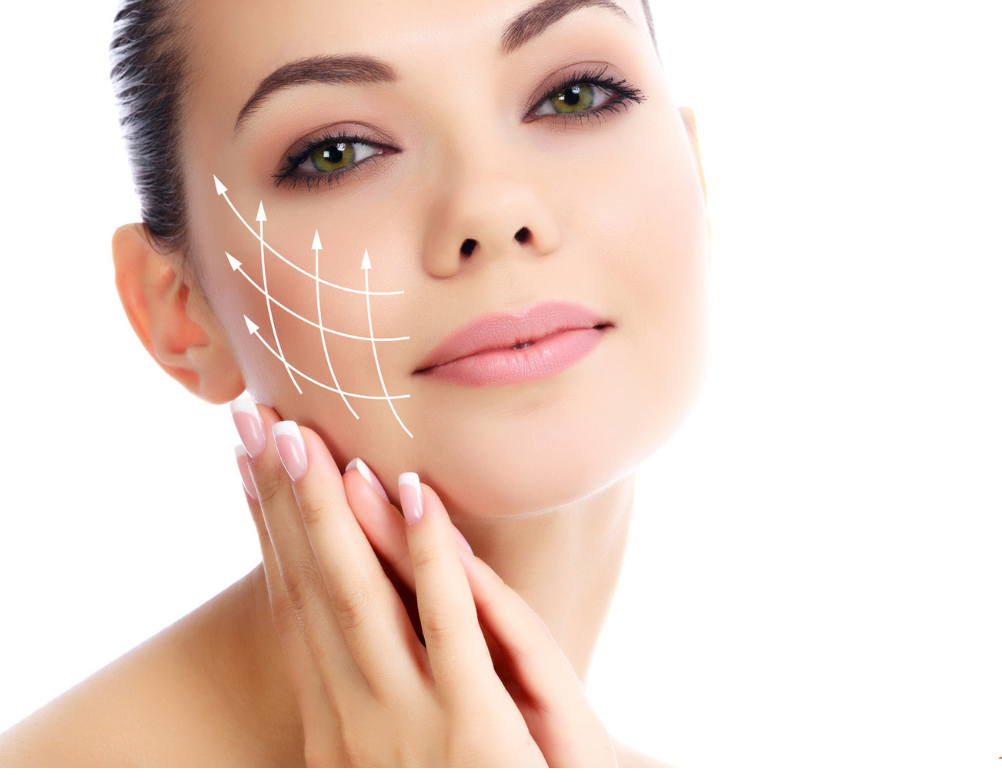
For many patients, the biggest advantage of having a thread lift rather than a facelift is the greatly reduced recovery time associated with thread lifts. When a patient has facelift surgery, he or she must be heavily sedated; as such, the patient must arrange for someone to drive him or her home from the hospital. Most facelift patients also require around the clock assistance from a caretaker for at least three days after they have surgery. Furthermore, if the patient still has children at home, childcare aid may also be needed. Facelift patients usually need to take one to two weeks off of work, too, in order to heal.
Recovery from a thread lift, on the other hand, is comparatively easy. Thread lifts can be performed under local, rather than general anesthesia, meaning that thread lift patients can drive themselves home and look after themselves immediately after having their procedure. While some patients will experience a little bit of soreness, redness and swelling after having a thread lift and therefore wish to take the rest of the day off, most can return to work immediately. Strong pain medication is seldom needed after having a thread lift, making it easier for patients to return to their normal routine. This procedure is therefore ideal for people who have children at home or those who have busy, demanding careers.
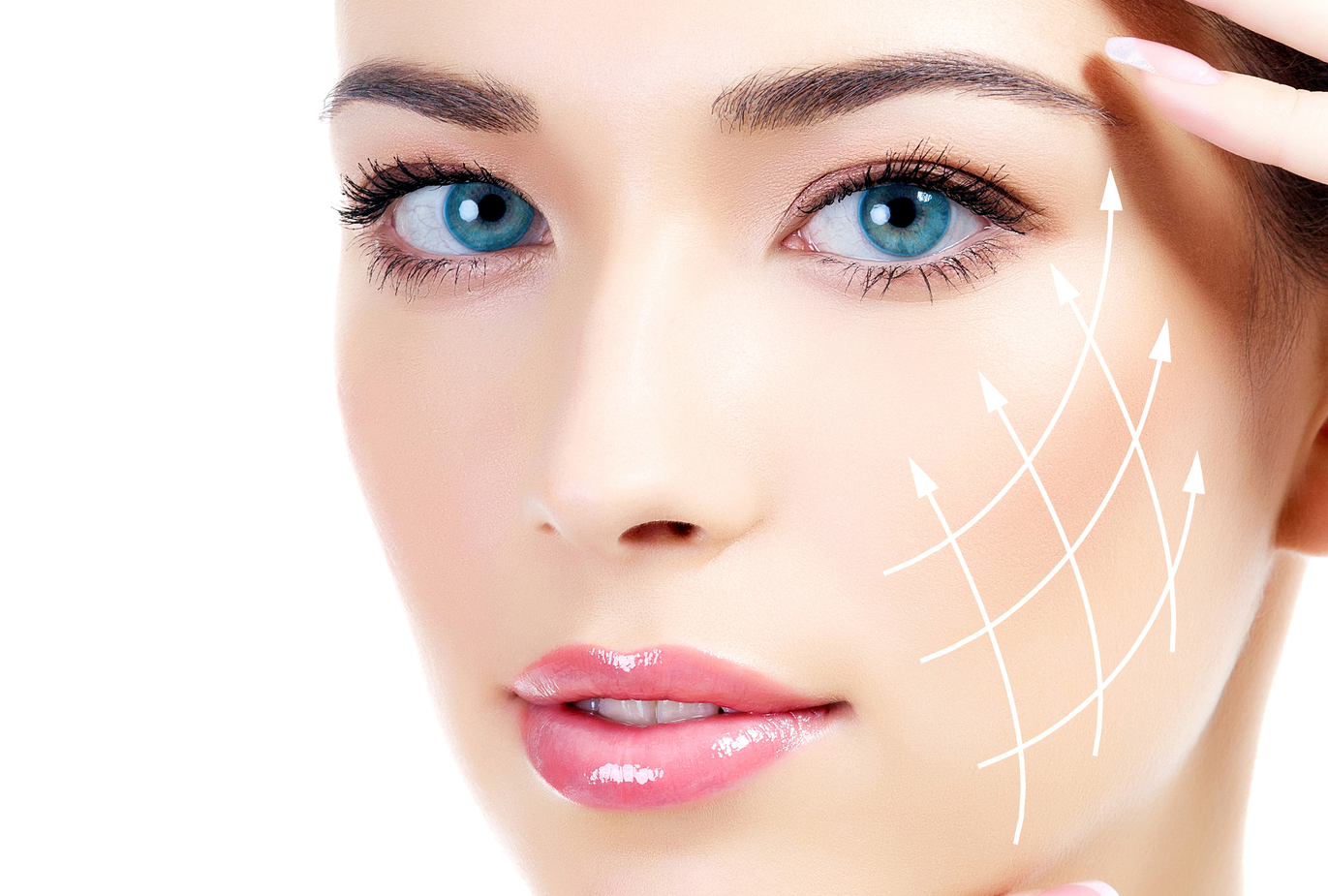
While thread lift recovery is not particularly intensive, patients will still have to take a few minor precautions while healing. It’s important to make sure that you don’t rub your face vigorously while cleansing it or applying moisturizer for at least a week after having threads placed. You should also try to prop your head up slightly so that you don’t roll over directly onto your face while sleeping.
Thread lifts are low risk, thanks to how noninvasive they are. There is virtually no risk of scarring, severe bruising, bleeding or other complications after having a thread lift. In rare cases, patients may experience irritation, infection or their sutures becoming visible under their skin. If this occurs, however, the sutures can simply be removed and the patient’s face will return to its prior state.
Finally, because thread lifts are much easier to perform than facelift surgery, they are much more affordable.
One of the best things about this treatment is it only takes about one hour. After that, you’re free to go back to work or whatever else you had scheduled for the rest of your day.
Before treatment starts, we will apply a topical numbing agent and local anesthetic to the treatment site. The needle used during this treatment is so fine it will not cause any pain. However, we provide anesthesia to ensure you feel no discomfort during the treatment.
Once the anesthetic has taken effect, your treatment will begin. The PDO threads are inserted via blunt tip needles, called cannulas, or sharp-tipped needles. Once inserted into the appropriate layer of skin, they act as anchors as the skin is lifted upwards. Then, the excess threads are cut off.
There are several types of PDO threads, and each serves its own unique purpose. Depending on your aesthetic goals, your PDO provider may use one or many thread types during your anti-aging treatment
There are two primarily types of PDO threads, These are floating non-barbed threads and floating barbed threads. Sub-classifications of non-barbed threads include braided threads and mono-filament threads. Sub-classifications of barbed threads include:
You may hear PDO threads described with names such as “heart barbs”, “tornado” or “double screw”. These are all references to various barbed PDO threads.

It absolutely matters what type or types are PDO thread is used during your PDO thread lift. Besides the distinct difference in shape, PDO threads come in varying lengths and thicknesses. Factors affected by the type of thread used include tensile strength, efficacy, quality and cost of treatment.
This treatment is completely safe. It is approved by the FDA for safety and efficiency. Moreover, hundreds of thousands of treatments have been performed and there are no reports of allergic reactions, sensitivities to the threads, or serious side effects or risks.
Since PDO thread lifts are non-invasive, there isn’t a lot you need to do to prepare. However, there are some precautionary measures you can take to ensure the best results from your treatment. Here are things you should avoid one to two days before treatment:
There are not a lot of special after-care requirements to this treatment. However, you should hold off on any dental treatments for the first two weeks after your PDO thread lift. Holding your mouth open for an excessive period of time can affect the results of your treatment. Moreover, you’ll want to sleep on your back for the first couple of weeks. This ensures you don’t put too much pressure on one side of your face.
A PDO thread lift is customized to your unique skin type, skin texture and aesthetic goals. Depending on the area you want treated, you may receive three or four carefully placed barbed threads. Different threads are used for varying degrees of lift, skin tightening and cellular rejuvenation.
Because a PDO thread lift is so versatile, it can treat virtually any area of the face. These include the:
The cheeks and the lower face/neck region are the most commonly treated. The cheeks and lower face are great regions to treat because they lend themselves so well to synergistic skin lifting treatments like HIFU therapy.
How long the PDO threads last depends on a number of factors, including the thickness of the threads, the quality of the threads and your body’s rate of metabolism. However, most of our clients find that the threads have dissolved within six to nine months.
Some results of the treatment, such as skin lifting and some of the contouring effects, are visible immediately after treatment. In fact, your skin may look tighter when you walk out of our office than it will a week later.
The final results of your PDO thread lift will be seen within one to two months of your treatment. How long it takes you personally depends a lot on your age. Your age is one of the leading factors in how quickly your body produces new, healthy collagen. Collagen is the protein responsible for plumping up your cheeks, filling in fine lines and smoothing out wrinkles.
Most of our clients enjoy satisfactory results after just one treatment. Come in six to nine months after your first treatment so we can determine if you need a follow-up treatment. After that, you shouldn’t need another treatment for three years.
If you’re looking to correct uneven lines, wrinkles, gaunt facial features or skin laxity of the face, you are a good candidate for a PDO thread lift. You are a particularly good candidate for this treatment if you want an instant facial lift but don’t have the time or money to commit to a traditional face The ideal thread lift candidate is usually in his or her late thirties to early fifties, whereas most patients over the age of about 55 will benefit more profoundly from facelift surgery. Thread lifts can, however, provide a facelift alternative for older patients who are unable to have surgery for medical reasons. Because thread lifts can be performed under local anesthesia, many people who have age-related conditions that make them ineligible for surgery (like high blood pressure, type two diabetes and cardiovascular disease) can safely have this treatment. If you have any outstanding health conditions, make sure to talk to your doctor about whether or not a thread lift might be right for you.
It’s important to understand that while no lifting technique can produce permanent results, facelift surgery will usually produce longer lasting results than a thread lift. The results of facelift surgery can last up to a decade, whereas a thread lift will generally last from one to three years. However, because the thread lift procedure is so low-risk, patients who like the results of their thread lift can usually opt to have a fresh set of temporary sutures placed once their old sutures are absorbed by the body lift.
The best complementary treatments to your PDO thread lift depend on the results you’re looking to achieve. If you are extremely concerned about lines and wrinkles exacerbated by facial motions, neuromodulators work best. If you’re more worried about static lines and wrinkles, dermal fillers are the perfect complement for your PDO thread lift.
Neuromodulators (e.g. Botox)
Neuromodulators are a type of injectable with the active ingredient botulinum toxin type A. Common examples include Dysport, Xeomin and Botox. Let us know during your initial consultation if you are planning on a treatment to complement your PDO thread lift. You can’t lie down for a couple hours after Botox to ensure the neurotoxin doesn’t spread outside the targeted area, so you will need to receive your PDO thread lift first.
How Do Neuromodulators Work?
Neuromodulators work by blocking the communication of neurotransmitters between your nerve endings and muscles. This reduces the activity of hyperactive muscles, temporarily eliminating lines and wrinkles which are apparent when your facial muscles are moving.
Dermal Fillers (e.g. Juvederm)
Dermal fillers work very similarly to PDO thread lifts in that they stimulate your body’s natural collagen production process. They contain the active ingredient hyaluronic acid, more commonly known as HA. One of the most popular FDA-approved dermal fillers is Juvederm. It comes in several variations, including Juvederm Ultra, Juvederm Ultra Plus, Juvederm Volbella and Juvederm Voluma XC.

Different Juvederm formulations are designed to treat different areas of concern. Juvederm Ultra Plus fills in deep parentheses lines and smooths deep nasolabial folds. It also adds volume to thinning lips and lasts approximately 50% longer than Juvederm Ultra.
Juvederm Volbella is designed to volumize the lips and smooth out the lines around your mouth. Juvederm Voluma XC safely and effectively lifts and contours the cheeks by restoring volume lost by the natural aging process. Note that this Juvederm formulation is denoted by an “XC” at the end. This indicates that the solution includes lidocaine, an anesthetic that ensures the treatment is completely comfortable.
